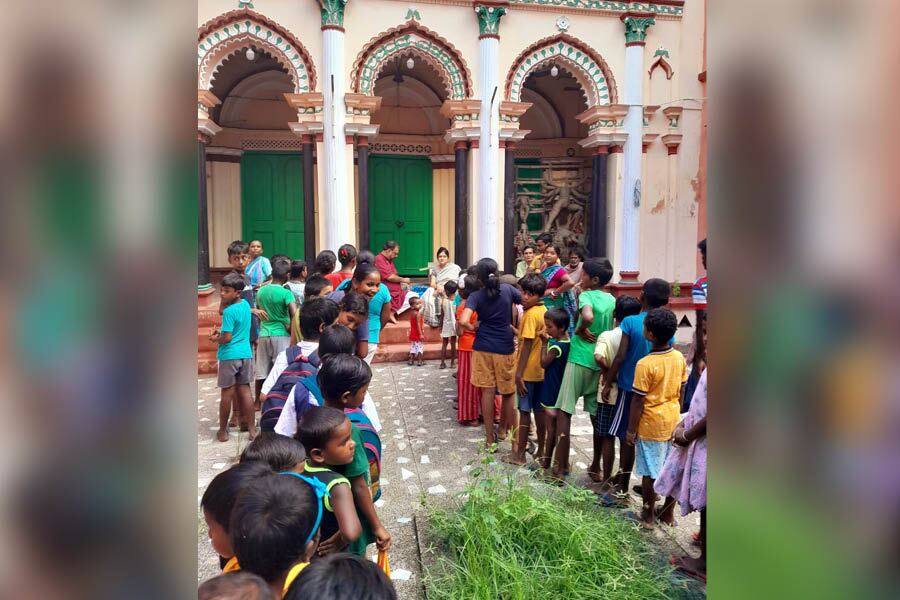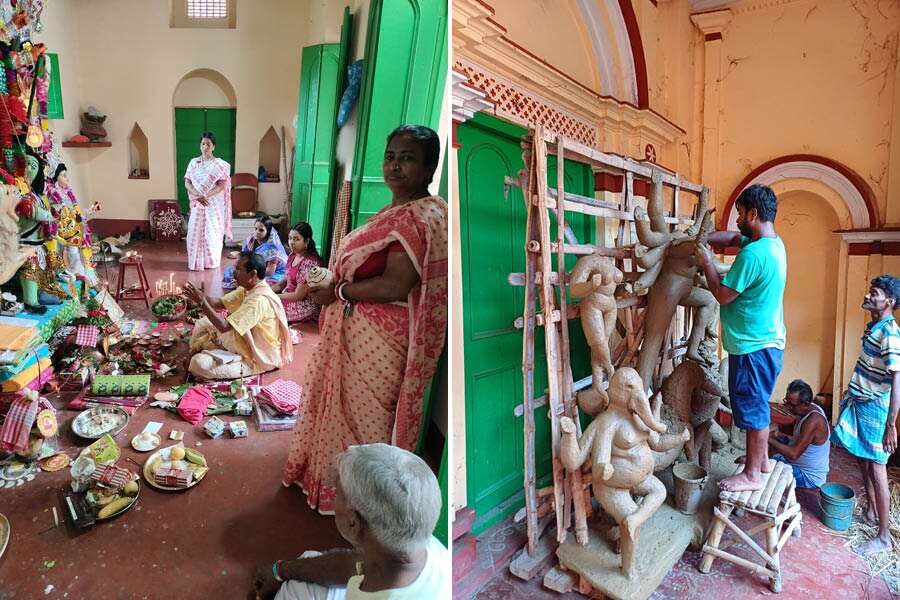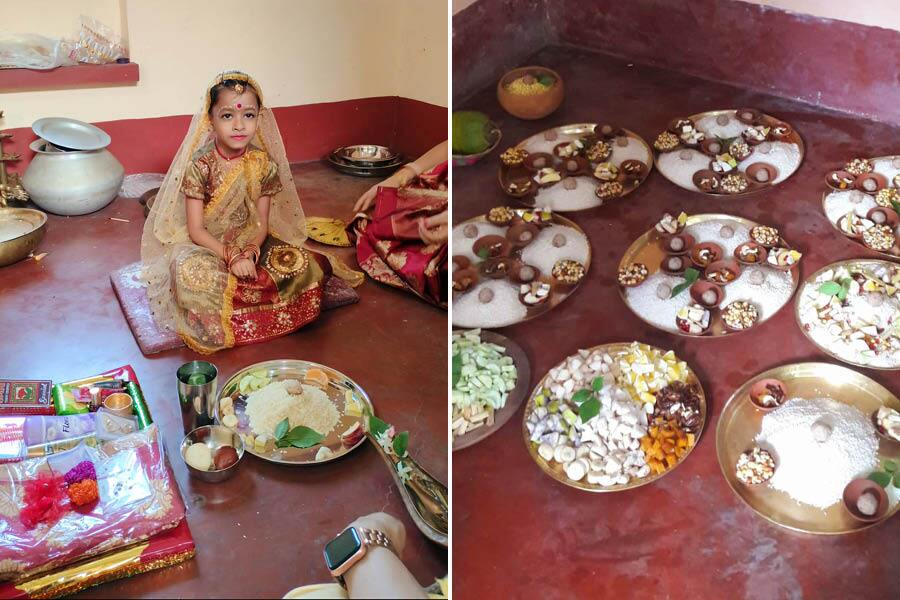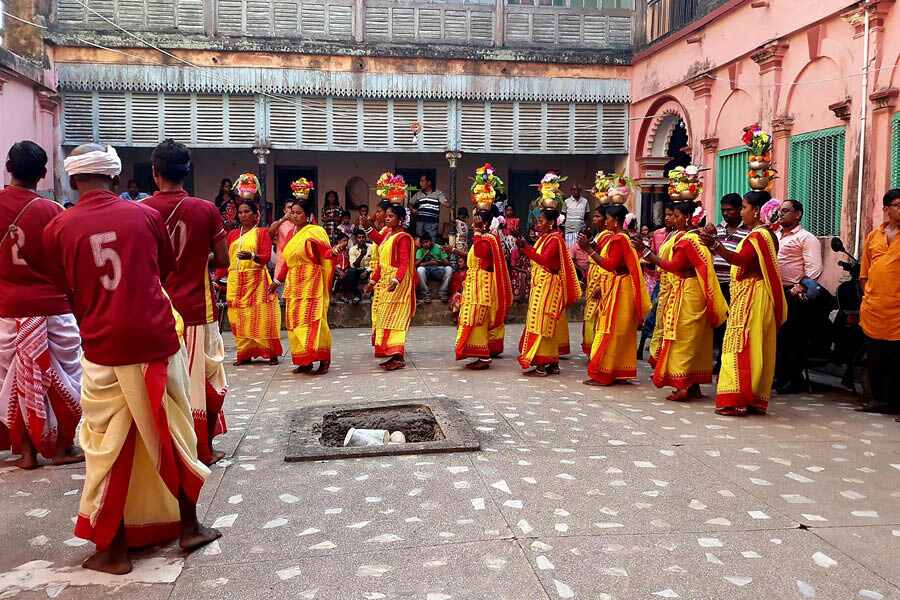As soon as Lord Cornwallis introduced the new land revenue system in 1793 in the name of permanent settlement, a new class of landowners known as zamindars emerged in the economic landscape of West Bengal as one of the major upper classes of society. Soon, these families organised big-ticket Durga Pujas across Bengal. From the last phase of the 18th century, there was a boom of family Durga Pujas in Bengal and religious sentiments aside, the display of status and wealth also played a role in the large-scale festivities.
During this new socio-political phase, one Krishnakanta Pathak won a fortune of land between what is today’s Chinsurah and Dhaniakhali from the East India Company. Pathak’s original family name was Chatterjee and over this huge stretch of the most fertile land Hooghly, which was once more than 10,000 bigha, his zamindari stretched over Chandpur, Maheshpur and Hiranya Bati. The village where he settled was called Talchinan, and in his home here he introduced a Durgotsav.

The doors of Pathak Bari are opened to visitors and the local community on the five days of Durga Puja
Today, more than 225 years later, Bengal has seen partition, the zamindari system is abolished and the Pathak family of Hooghly’s Talchinan have experienced social and economical tumults. The family still comes together in their ancestral house to celebrate the legacy and heritage of their barir Pujo and the scale of the festivities, though much reduced in comparison to their zamindari times, still have a regal touch.
Family tales
While the family is now spread out geographically, the financial responsibility of the celebration is taken up in turns by the members, who arrive at the home a week before Durga Puja, and celebrations kick off by distributing gifts to children from the local community. As the five days of Pujo begin, the doors of Pathak Bari, the ancestral zamindar home, is opened up for visitors and the village.

Family members distribute gifts among children in the village a week before Durga Puja
In the past, a village fair in front of the Pathak’s family temple, and special fireworks on every night of Pujo were some of the highlights of the celebrations. Today, Navami is marked by a big festive feast where the entire village is invited, and a dance performance by local tribal communities.
After Krishnakant, the puja was carried on by his son Gourmohan Pathak. However, after Gourmohan’s demise, when Ishwarchandra Pathak was the family head, the Durga Puja stopped for nearly 12 years for reasons best known only to the family. Nearly 120 years ago, it was re-started by Madan Gopal Pathak or his son Tinkari Pathak, and ever since the family puja has continued without a break, braving many social, political and financial challenges.
Presently the puja is organised by the branches of the family from Kalipada Pathak and Karunamoy Pathak, grandons of Madan Gopal Pathak.
Vaishnav traditions

The Durga Puja is performed following Vaishnav traditions, with the Kathamo Puja taking place on Janmashtami
The family’s Vaishnav beliefs reflect in the Durga Puja rituals as well. The kathamo pujo happens on Janmashtami — an exception from the common practice across many such zamindari families, where this happens on the day of Rath Yatra. Since the puja follows Vaishnav traditions, no animal sacrifices or non-vegetarian food are offered to Devi. While Ashtami is a day for strictly niramish vegetarian food, family members are allowed to have fish on Saptami and Navami. The goddess is offered both cooked and uncooked food prepared by the women of the family. Widows are allowed to take part in all supporting activities.
Even today, certain familial traditions like firing a gun to signal Sandhi Puja are followed, along with rituals like Kumari Puja on Ashtami and the nabapatrika snan on Saptami.

Kumari Puja on Ashtami, and strictly vegetarian food for the goddess are traditions of the Puja
Community ties
Decades ago, the Pathak family gifted portions of their lands in the village to dhaakis, potters, priests and idol makers, who supported the family through Puja. As a result, generations of the same families have been involved in the puja till today. The name of the present idol maker is Krishna Pal whose father had also done the same job for Pathak family puja in the past.

A folk dance performance by local tribal communities is the highlight of Navami celebrations
Tribal communities like the Bagdis and Santhals are among the locals settled in and around Talchinan, and these tribal communities have also played an important role in the puja. On Navami, a large group usually performs traditional folk dances accompanied by the beat of drums and traditional instruments in reverence of the goddess. Women of the Pathak family would join the dancers as a symbol to foster bonds between the zamindar and their ‘subjects’. While the socio-cultural setting is different, the dances continue and the women of the family still join in.
Another tradition on Navami day is the community luncheon for the village where nearly 2,000 enjoy a festive meal. On other days like Saptami, Ashtami and Dashami, about 1,200 people have lunch at the house, and on Dashami luchi and bonde is served to all attendees.

Before the visarjan, women of the Pathak family and women from the local communities and villages all gather for the boron and sindoor khela
On the day of immersion, men from the tribal communities lift the Durga idol on their shoulder and carry it to the pond where the visarjan takes place. The pond is only used for this purpose, and no other activities are permitted through the year.
Before the visarjan, women of the Pathak family and women from the local communities and villages all gather for the boron and sindoor khela. After immersion, the family’s young members write Durga Sahai with the vermillion on banana leaves.
For members of the Pathak family, like Indranil Pathak, this time is about celebrating the legacy of the family. Like every year, he will be at his ancestral home to be a part of 227 years of tradition, and to revisit dol mancha and Durga dalan — parts of his ancestral home that predates even the two-century-old Puja.


